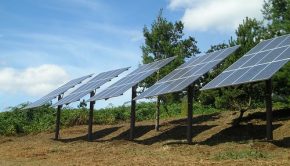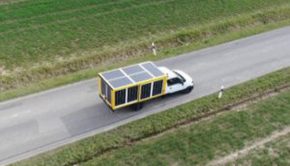10 Victories for Virtual Power Plants in 2020
10 Victories for Virtual Power Plants in 2020

2020 forced most people into a more distributed and virtual way of life. But a segment of the grid edge industry has been trying to achieve that for years, installing controllable devices at homes and businesses that can work together to help the grid.
This concept goes by various names — virtual power plants, flexible loads, behind-the-meter networks — and encompasses tools like rooftop solar, batteries, smart thermostats, smart appliances and electric vehicle chargers. Though small individually, distributed energy resources are projected to grow to 387 gigawatts in the next five years, according to research by Wood Mackenzie.
Aggregated resources are still far from full integration into the workings of the grid. But virtual power plants hit several milestones this year and pushed their deal count higher than ever before.
Here is a summary, in more or less reverse chronological order, of major projects, deals, investments and acquisitions in this space from this tumultuous year.
Confused about this jargon? Check out GTM’s explainer: So, What Exactly Are Virtual Power Plants?
PG&E signs up for major commercial battery fleet
The clean energy news cycle never really slowed down this year, and the news keeps coming. Two days before Christmas, California utility PG&E announced contracts for 387 megawatts/1,548 megawatt-hours of new energy storage. That scale of investment would have blown minds in any other year, but in 2020, massive California battery deals lost their shock value.
What did stand out was a 27-megawatt/108-megawatt-hour fleet of customer-sited batteries to be developed by Nexus Renewables of Ontario, Canada. The batteries will sit at commercial and industrial sites, helping those entities manage power bills and boost resilience. But the aggregated systems will help the grid with peak power and regulation services, which increase the carrying capacity for solar power in the area.
That’s the biggest behind-the-meter fleet for PG&E, which has largely contracted for very large batteries. Southern California Edison signed even bigger commercial storage deals in years past, with companies like Stem and AMS. But utility procurement of commercial and industrial batteries at that scale had not been repeated.
Swell Energy raises $450 million financing facility
For a financial vote of confidence in the virtual power plant business model, look no further than Los Angeles-based Swell Energy’s recent deal to access up to $450 million of project financing for home batteries.
The company won several utility contracts, including two with Southern California Edison, to aggregate capacity in particular parts of the grid. The new funding, to be made available from Ares Capital Management and Aligned Climate Capital, gives this venture-backed startup a lower cost of capital to build out the equipment needed to deliver on grid services contracts. All told, the partners are targeting 14,000 home storage systems.
The financing deal, which also came with a direct corporate investment in Swell, shows that residential storage units, backed by secure revenue streams from a utility, are now an asset class that at least some infrastructure investors want a piece of.
“It’s capital markets showing favor, not just for the projects, but the platform as well,” CEO Suleman Khan told GTM.
OhmConnect turns residential flexibility into investable infrastructure
Residential demand response startup OhmConnect pulled off a similar feat, but it managed to package flexible load as infrastructure.
Alphabet-backed Sidewalk Infrastructure Partners invested $100 million in OhmConnect — $20 million as direct equity investment in the company and the rest as project financing to aggregate a 550-megawatt virtual power plant called Resi-Station. OhmConnect will use the cash to outfit California homes with smart plugs, smart thermostats and similar devices, which it harnesses to deliver capacity to the grid, making money in the process.
That kind of “power plant” cannot discharge electrons in the same way batteries can, or for as long. But OhmConnect has built up a track record of eliminating demand during peak hours, and it can do so with far less upfront expense than a more infrastructure-heavy approach. That means Resi-Station could scale quickly to help California fight next year’s summer peaks.
Sunrun expands battery fleet, wins more deals
The nation’s largest rooftop solar installer has made virtual power plants a major strategic focus and a mainstay in its pitch to investors.
This year, the company passed 13,000 installed home storage systems and won several more contracts to put them to work. That includes a 300-home demonstration with New York utility Orange & Rockland, and a 20-megawatt program with Californian community choice aggregators to deliver customer resilience and peak load reduction.
After establishing a test run with Southern California Edison’s customer service division, Sunrun won a full-fledged contract with that utility to deliver 5 megawatts from thousands of homes over a 10-year, fixed-price term, which starts in 2023.
This summer, news broke that Sunrun partnered with Autogrid for cloud-based software to dispatch its virtual power plants, rather than trying to build that capability in-house.
Stem goes SPAC
Cleantech companies flocked to special purpose acquisition companies (SPACs) this year, entering public markets via merger with an existing shell company. That trend included several automotive startups and battery hardware manufacturers but also distributed storage company Stem.
Stem developed a genre-defining commercial battery fleet in Southern California. More recently, it shifted focus to supplying developers of solar-paired batteries with the software to operate storage and maximize market returns. After raising a couple hundred million dollars in equity investment, the startup aims to debut on the New York Stock Exchange early next year with an equity value of $1.35 billion.
AMS, a competitor in the early Southern California virtual power plant (VPP) market, exited this year via acquisition by storage integrator Fluence. AMS had pivoted to delivering software as a service for clean power plant operators in competitive wholesale markets.
Now it’s up to Stem to convince public markets that storage operation and aggregation software is worth betting on.
Generac buys Enbala
Startup Enbala, whose software controls 600 megawatts of distributed devices, got acquired in October by home backup leader Generac.
The companies did not disclose the selling price, but Enbala CEO Bud Vos called it “a very large success” for his investors. The deal provides financial stability and new pathways to growth for the software provider. Generac dominates the home generator market and has acquired several grid edge companies to break into the home solar-storage market. The Enbala deal suggests Generac wants a piece of the emerging VPP market too — and raises the possibility that its existing fleet of home generators could become more active grid participants.
FERC opens up markets for distributed energy
The Federal Energy Regulatory Commission endorsed distributed energy as a player in the nation’s power markets with Order 2222, passed in September. The order says that aggregations of distributed resources must be able to compete in the organized markets that FERC oversees.
The ruling won’t immediately move markets, though: Grid operators have 270 days to file their compliance plans. Full implementation is still a ways off and depends on resolving cross-jurisdictional issues between the governance of the low-voltage distribution grid and the bulk power markets. But the decision confirms that federal regulation is moving in a generally more friendly direction for virtual power plants.
Distributed resources fought California blackouts
Amid a record-breaking heat wave across the U.S. West, California grid operator CAISO was forced to institute rolling blackouts during the evening hours of two consecutive days in August. But the state pulled itself back from further blackouts, in part due to assistance from a diverse crew of distributed assets. Companies including Stem, Enel X, Leap, OhmConnect and others collectively delivered hundreds of megawatts of load reduction from distributed resources, during the crucial hours when every megawatt counted.
Those providers were able to point to their performance, and call out California policies that prevented distributed energy from helping even more.
PGE launches utility-owned VPP
Portland General Electric has ambitious plans to install 200 megawatts of distributed capacity across its Oregon territory. But before it does that, it’s starting with a 525-home virtual power plant, launched this summer.
Participating homes will receive compensation for letting PGE control batteries for a broader than usual array of grid services, including capacity, frequency response, grid upgrade deferral, energy arbitrage and volt/VAR control. It will be up to the utility to ensure that participating customers feel like they’re getting a fair deal.
Vermont’s trailblazing VPP gets permanent approval
After several years piloting home batteries, Vermont utility Green Mountain Power has assembled a fleet of 2,567 Tesla Powerwalls that add up to 13 megawatts of flexible capacity. Those devices helped save the utility more than $3 million this year by lowering demand during peak hours, and they also delivered more than 16,000 hours of backup power to their host customers.
In May, Vermont regulators approved a permanent battery tariff, ensuring the program will continue to grow. Customers can either lease Powerwalls from the utility or buy a battery of their choice and get a credit from the utility of up to $10,500 for connecting it and responding to commands.








